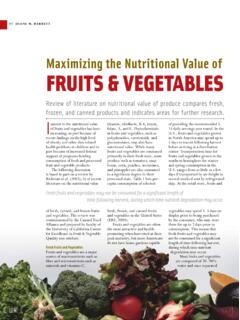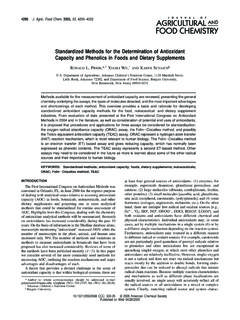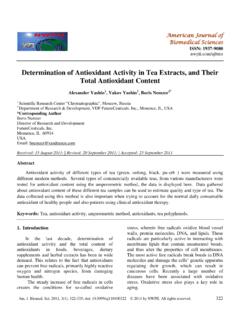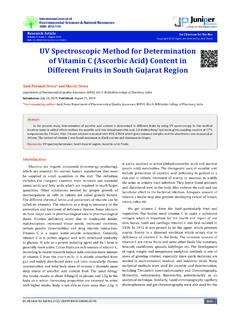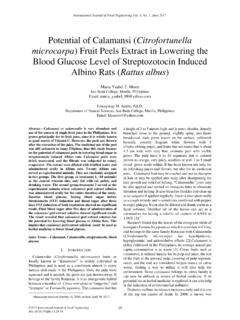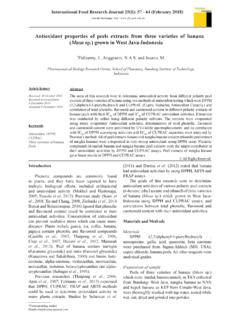Transcription of Quantitative Determination of Vitamin C Concentration of ...
1 Article Volume 10, Issue 3, 2021, 2361 - 2369. Quantitative Determination of Vitamin C Concentration of Common Edible Food Sources by Redox Titration Using Iodine Solution Laxminandan Satpathy 1,* , Naganandini Pradhan 1 , Deeptimayi Dash 1 , Priyanka Priyadarshini 2 1,*. Baral , Siba Prasad Parida 1 Department of Zoology, School of Applied Sciences, Centurion University of Technology and Management, Bhubaneswar, Odisha, 752 050 India; ( ); ( ); ( ); ( );. 2 Department of Zoology, Dhenkanal Autonomous College, Dhenkanal, Odisha, 759 001 India; ( );. * Correspondence: ( ); ( );. Scopus Author ID 57197747626.
2 Received: ; Revised: ; Accepted: ; Published: Abstract: Vitamin C is isolated in 1928 and associated with hemorrhagic disease scurvy. Vitamin C is crucial for the development and maintenance of connective tissues in humans. It plays an important role in maintaining healthy gums, helps in wound healing, bone formation, relief from a common cold, and several metabolic functions. It is an antioxidant that safeguards the cells from free radical damage. It is used as a curative agent in many diseases and disorders. This research article attempts to find different concentrations of Vitamin C in common edible foodstuffs.
3 The iodine redox titration method is used for Vitamin C quantity evaluation. This study is based on the Vitamin C quantity of 27 common edible food sources, including lemon (Citrus limon), lime (Citrus aurantiifolia), navel orange (Citrus sinensis), grapevine (Vitis vinifera), fox grape (Vitis labrusca), pomegranate (Punica granatum), apple (Malus domestica), kiwifruit (Actinidia deliciosa), Indian tamarind (Tamarindus indica), holy basil (Ocimum tenuiflorum), coriander (Coriandrum sativum), tomato (Solanum lycopersicum), carrot (Daucus carota), radish (Raphanus sativus), bitter gourd (Momordica charantia), garlic (Allium sativum), onion (Allium cepa)
4 , potato (Solanum tuberosum), aubergine (Solanum melongena), bell pepper (Capsicum annuum), pea (Pisum sativum), common bean (Phaseolus vulgaris), pumpkin (Cucurbita moschata), pawpaw (Carica papaya), cucumber (Cucumis sativus), cabbage (Brassica oleracea var. capitata), and cauliflower (Brassica oleracea var. botrytis), are evaluated. The highest quantity of Vitamin C present in Indian tamarind, , mg/100 g. This study is intended to use new Vitamin C sources for nourishment. Keywords: Vitamin C; COVID-19; diseases; immunity; iodine solution; redox titration. 2020 by the authors. This article is an open-access article distributed under the terms and conditions of the Creative Commons Attribution (CC BY) license ( ).
5 1. Introduction Vitamins are essential organic nutrients that are required for various biochemical and physiological processes in the human body. Vitamins are classified as water-soluble (B. complexes and C) and fat-soluble (A, D, E, K) vitamins based on their solubility. Vitamin C. was first isolated in the year 1923 by Szent-Gyorgyi and synthesized by Haworth and Hirst [1]. Vitamin C is also known as L-ascorbic acid [2]. It is required for the biosynthesis of collagen fibers, L-carnitine, and some neurotransmitters; Vitamin C is involved in protein metabolism 2361. [2, 3]. Collagen is an important component of connective tissue, which plays a vital role in wound healing.
6 Vitamin C is also an essential physiological antioxidant [4], and it regenerates other antioxidants within the body, including Vitamin E (alpha-tocopherol) [5]. Ongoing research is evaluating whether Vitamin C restricting the damaging effects of free radicals through its antioxidant property. It might prevent or delay the development of certain cancers, cardiovascular disease, and other diseases in which oxidative stress plays a crucial role [6, 7]. In addition to its antioxidant activity and biosynthetic functions, Vitamin C plays a vital role in immune function [5] by improving the absorption of nonheme iron [8], the form of iron that presents in plant-based foodstuffs.
7 The deficiency of Vitamin C causes scurvy, characterized by capillary fragility, connective tissue weakness, and lassitude [2, 3, 5, 9-12]. Pauling suggested that ingestion of 1 3 g of Vitamin C effectively prevents the common cold [13]. Regular use of Vitamin C supplements shortens the time span of the common cold but does not reduce the risks of contracting a cold except for a person undergoing heavy physical activity [14]. A novel human coronavirus has been recently identified, the severe acute respiratory syndrome (SARS) coronavirus (CoV) 2, which causes the fatal coronavirus disease 2019.
8 (COVID-19) [15]. During the outbreak of SARS-CoV-1 in 2003, the use of Vitamin C was suggested as a nonspecific treatment for severe viral respiratory tract infections [16-19]. In chick embryo tracheal organ cultures, Vitamin C shows increased resistance to infection caused by an avian coronavirus [20]. Many patients with severe COVID-19 have raised levels of mediators interleukin-6 and endothelin-1, which can be reduced by administering high doses of Vitamin C [15]. Numerous abstracts are showing that Vitamin C may affect the immune system by transforming the T lymphocyte and production of interferon [21, 22].
9 Some studies demonstrated that in guinea pigs maximum tensile strength of scar tissue was achieved after supplementing Vitamin C due to biosynthesis and collagen accumulation [23]. In recent studies, it has been found that the supplementation of Vitamin C with Vitamin E relieves oxidative stress in the blood and tissues of diabetic aged rats by modulating the antioxidant status and lipid profile [24, 25]. Many studies showed the beneficial effect of Vitamin C against heavy metal toxicity. Lead is one of the common environmental pollutants in which Vitamin C's protective role is extensively studied [26].
10 Oral supplementation of Vitamin C with antipsychotic drugs reverses ascorbic acid levels, reduces oxidative stress, and enhances the brief psychiatric rating scale (BPRS) score. Hence, in amalgamation, both drugs can be used in the treatment of schizophrenia [27]. Curcumin might increase Vitamin C's effect in protecting the function of endothelial cells through its antioxidant with hypoglycemic and hypolipidemic actions [28, 29]. Approximately 70% 90% of Vitamin C is absorbed by the cells at moderate intakes of 30 180. mg/day. But, at doses above 1 g/day, Vitamin C absorption is less than 50%, and unmetabolized ascorbic acid is excreted in the urine [5].

